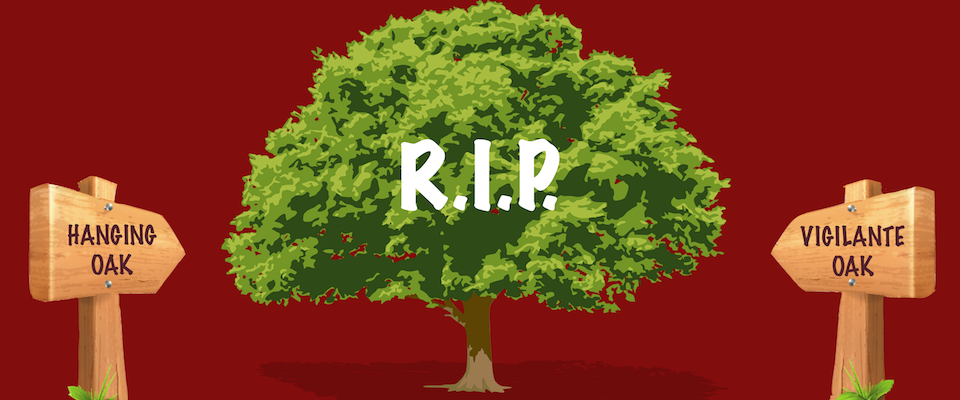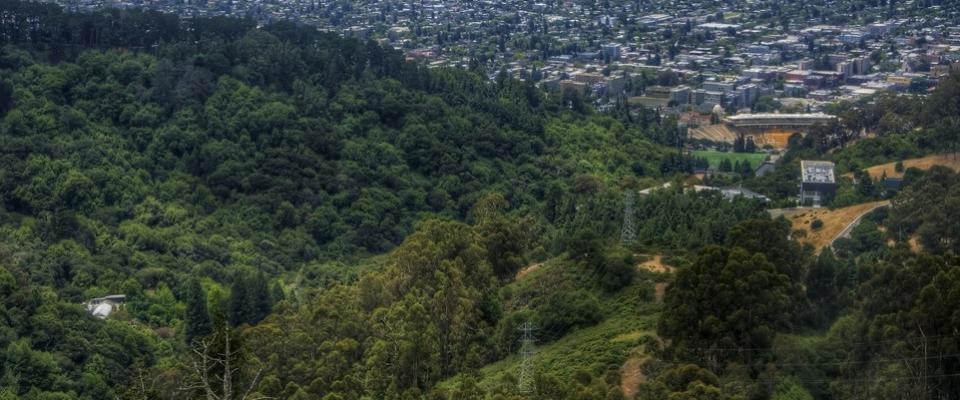The towering old oak tree that stood east of Shattuck Avenue along Allston Way in Berkeley’s early days was known by many names, two of them rather ominous: The Vigilante Oak, some called it. Others referred to it as the Hanging Oak.
The macabre monikers allude to a violent moment in the community’s colorful past–sometime in the 1850s, before Berkeley got its name–when a hard-luck livestock thief was strung up from the tree in an act of frontier justice.
Whether it’s historical or just another tall tale is still up for debate. But as Berkeley historian and contractor Richard Schwartz sees it, factual or not, the lore of the tree still has some bearing on local history. A full century before tree-sitters took to the oak grove outside Cal’s Memorial Stadium and refused to come down, the Hanging Oak was the focal point of one of the town’s first environmental battles.
It was stoked in part by an early Berkeley character named John E. Boyd, a writer and roustabout heralded by some as the town’s answer to Mark Twain.
Schwartz considers the one-time Civil War hero a social and intellectual prototype of the Berkeley bohemians, beatniks, hippies and free spirits to come. “The eccentrics of yore were amazing, talented people,” he says—folks who “followed their own drummers to a tee.”
Boyd, according to Schwartz, was “one of the great editorialists and working-class heroes of early Berkeley; the expressman known in town as the ‘Boss Baggage Buster of Beautiful Berkeley.” He wrote about him and other such characters in his 2007 book, “Eccentrics, Heroes, and Cutthroats of Old Berkeley.” In it, Schwarz devotes an entire chapter to the Hanging Tree mystery, finally concluding to his own satisfaction that the story sprung from Boyd’s imagination.
Why would he invent such a yarn?
Boyd told his tall tale for good reason, Schwartz says: He wanted to save the venerable tree from the woodcutter’s axe and make a statement about what he considered runaway development.
In an era generally regarded as pro-business, Berkeley historian Richard Schwartz says “the tree represented the town as a rural place,” a powerful symbol of simpler days. “There were differing views of the future. One was progress. The other was nostalgia.”
“There was tremendous change going on at the time as Berkeley transformed from a rural outpost into a more urban place,” Schwartz says. “Places that the town’s early pioneers regarded as sacred were being torn down.”
In an era generally regarded as pro-business, Schwartz says “the tree represented the town as a rural place,” a powerful symbol of simpler days. “There were differing views of the future. One was progress. The other was nostalgia.”
Boyd was well-known around town. A baggage handler (an early precursor to the taxi driver), he waited at the railroad station to transport travelers’ bags to their hotel.
“He was all over town and he saw everyone,” Schwartz says. “He was friends with both bums and the mayor and got along with all of them. He had his finger on the pulse of everything. He had a huge heart. And he wrote amazingly funny editorials for the local newspaper.”
Boyd actually told two versions of the Hanging Tree tale. The first, written in an 1887 letter-to-the-editor published in the Berkeley Advocate, was about the town’s first-ever trial in 1851. According to the story, which Boyd claims to have heard from a local old-timer, Berkeley resident William Harding was charged with stealing hogs. “A jury was quickly found and the court sat under the old oak tree,” Boyd wrote.
From there, things got a little fanciful. One of the jurors announced that he needed a drink of whisky to slake his thirst and the prisoner offered to pay for it.
Another juror declared “that he be hanged if he ever sat on a jury without whisky and he was not going to begin now.”
Thus, a horseman known as “Whisky Jack” was dispatched to fetch several bottles, which were quickly consumed.
The jury eventually fell asleep under the tree, and a police captain who sympathized with the would-be thief winked and pointed to the foothills. “The prisoner,” Boyd wrote, “took the hint and not waiting to take a formal adieu, or not liking to disturb the sleeping multitude, quickly crept away through the tall grass.”
Years later, the future of the landmark oak tree was in jeopardy. Upgrades to Allston Way caused the tree to suddenly protrude into the street and officials announced plans to cut it down. Critics fought back; they called to preserve the tree with an ornamental fence.
“For a lot of people this was a meaningful tree,” Schwartz says. “And I think it was a noble attempt to do whatever it took to save it.”
In 1902, 15 years after the first published tale of his beloved oak, Boyd told another. This one, which also ran in the Daily Gazette, told the story of a horse thief with the unlikely name of Cloromenda Mendoza, who was hanged there in 1851. He was put to death by, as Boyd described them, “enraged rancheros” known as “the Vigilantes of Ocean View (as Berkeley was then designated).”
In a subsequent letter to the newspaper, published under the headline “Preserve Famous Old Tree,” Boyd claimed that a group called the Native Sons of the Golden West planned to place a sign on the oak that would read: “Vigilante Tree. Upon this limb a Horse Thief was hanged, May, 1851.”
While researching his book, Schwartz began to have his doubts. “In Berkeley of the 1850s, there weren’t a lot of ranchers like the ones he talked about just floating around,” he says. “The story just didn’t smell right.”
Still, the historian gives Boyd credit for trying. “For a lot of people this was a meaningful tree,” Schwartz says. “And I think it was a noble attempt to do whatever it took to save it. The research shows he changed his accounts of the tree when it was in danger.”
As the debate over the Hanging Tree heated up, Boyd continued a strategy that would also serve later Berkeley radicals: He waged his war in the press, publishing another letter imploring that the tree be saved—but to no avail.
In 1908, developers prevailed and officials felled the tree. In the oak’s final months, Boyd published a 20-line poem ode in the Daily Gazette that began:
“Aye, cut it down, ye ruthless sons
Of Berkeley’s lovely clime;
Aye, cut it down and burn it up—
It has outlived its time.”
The poem was signed, “Boyd, the Boss Crank of Berkeley, January 14, 1908″





















